SEO
5 Trends to Know in SEO & Content Marketing
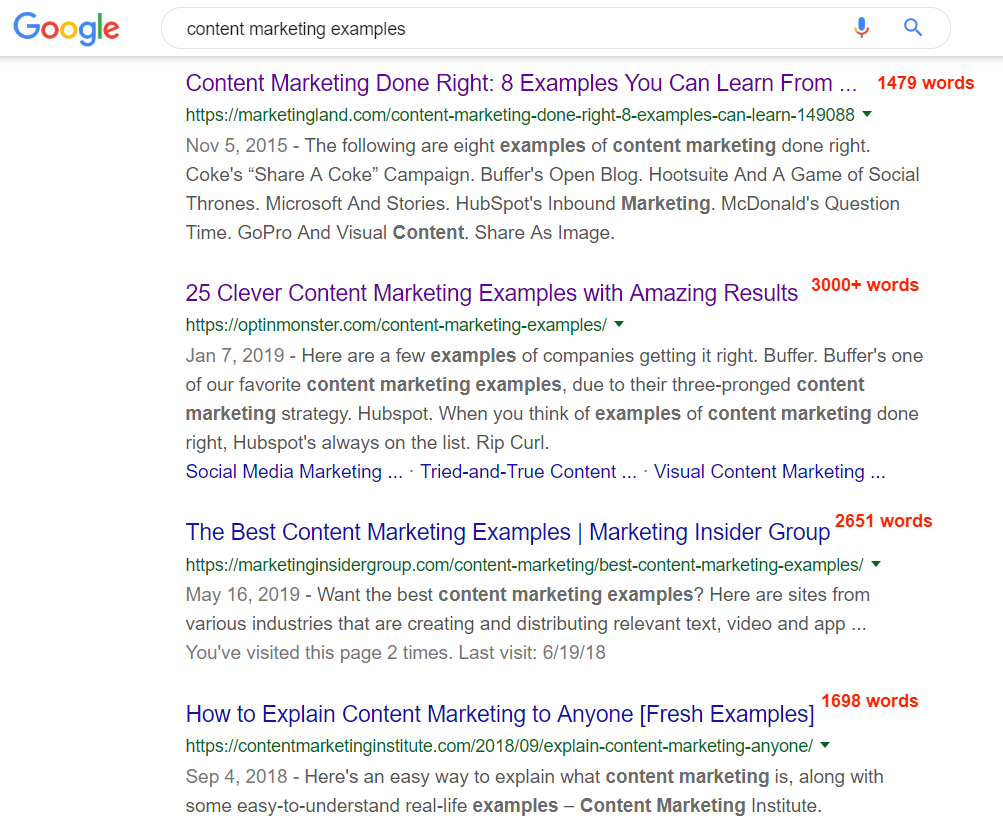
What’s trending in content marketing and SEO these days?
Let’s say this: Content is more important than ever.
More specifically, quality, media type, authenticity, and audience targeting all come into play if you want to win with readers and Google.
Ready to learn more?
These are the five content marketing and SEO trends you need to know.
1. Go Beyond (WAY Beyond) Superficial Content
We’re seeing brands leave superficial content behind in favor of blogs and articles that plumb the depths of a topic.
That means more and more blogs are comprehensive, thoroughly researched and – you guessed it – long.
For instance, look at the SERP for the query [content marketing examples]. The top 4 results have an average length of 2,207 words.

Furthermore, all these results are chock-full of real-world examples, studies, statistics, and facts.
This research had to be accurately and carefully compiled, referenced, and cited.
This Optinmonster blog (result #2 and a featured snippet) is well-researched, meaning it includes lots of examples, links to sources, and screenshots. It also clocks in at over 3,000 words:
This is what is necessary to rank well with readers and search engines these days.
Still publishing unplanned, unresearched, fly-by-the-seat-of-your-pants content?
Not going to work anymore. In fact, I could argue this method never worked in the first place.
Superficial content will get you superficial results, at best. There is rarely any value in content that skims the surface of a topic.
No value = no audience interest. No audience interest = no results.
2. Invest in Content Creation Processes
To create best-of-the-best content, more brands than ever are investing in content creation processes.
According to Content Marketing Institute’s 2019 B2C research, 56% of content marketers increased spending within the last 12 months on content creation.
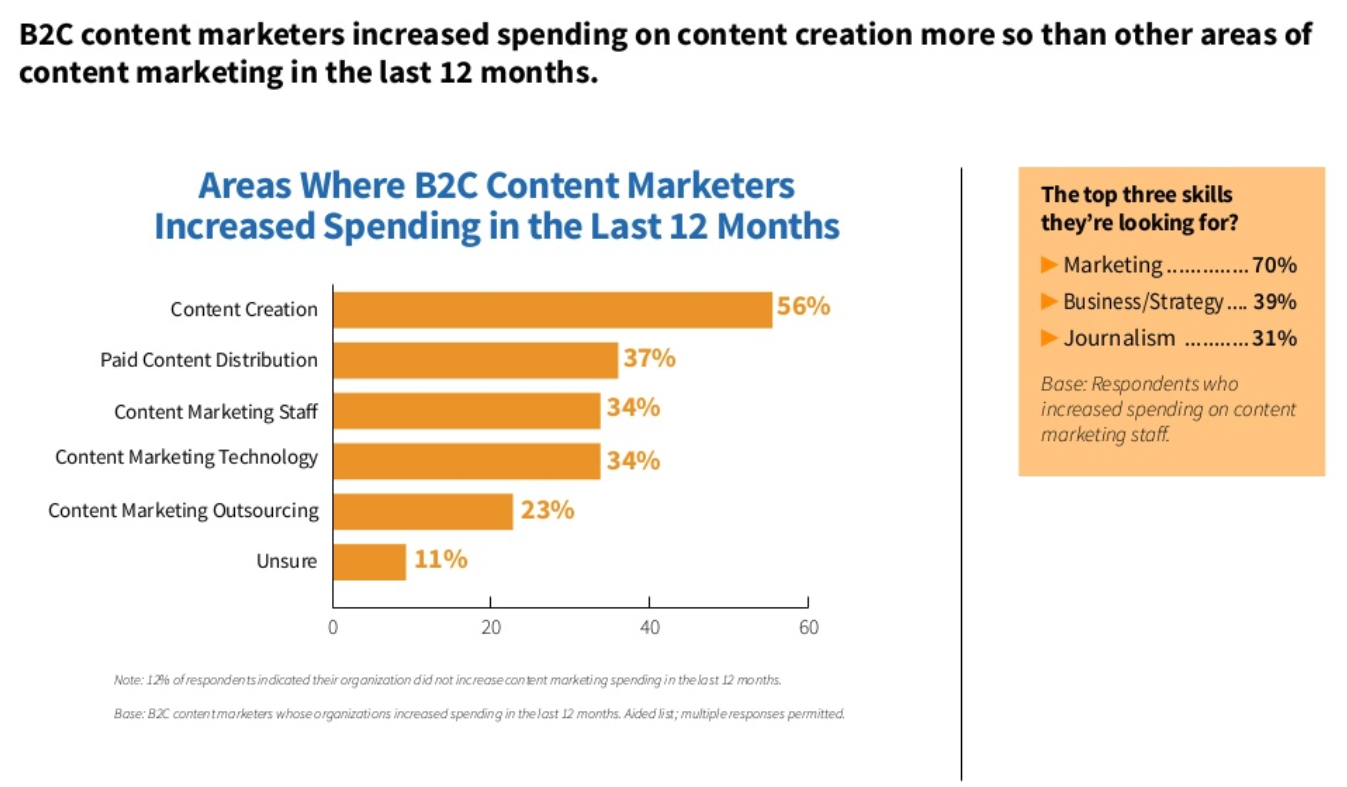
That might involve:
- Researching keywords and topics.
- Planning what the content will cover (and why).
- Writing the content.
- Optimizing.
- Editing.
- Creating graphics, pulling screenshots, or leveraging the written content into multimedia.
- Posting and promoting the content across multiple channels.
The interest in creating content is a matter of course.
Content marketing has reached peak popularity over the last few years, according to Google Trends.
Most marketers want a piece of the promised land.

Investing more dollars in content creation processes makes sense:
How else can you create the type of value-packed, high-quality content that readers love and search engines rank?
If you don’t invest, you won’t have the resources to do it right.
End of story.
3. Use Content Personalization for Ultra-Targeted Content
Another widely-adopted content marketing trend is content personalization.
According to a survey from Evergage, 93% of marketers use personalization for at least one channel in their digital marketing strategy.
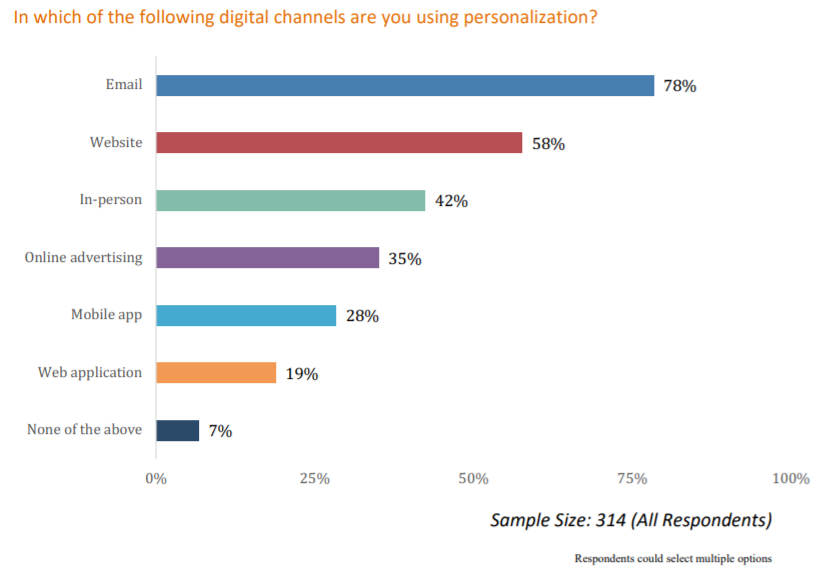
This practice focuses on tailoring the content your site serves to different users based on readily available personal data like demographics, preferences, and search/browsing history.
According to the Evergage survey, most marketers agree that this tactic:
- Helps deliver better customer experiences.
- Increases customer loyalty.
- Generates measurable ROI.
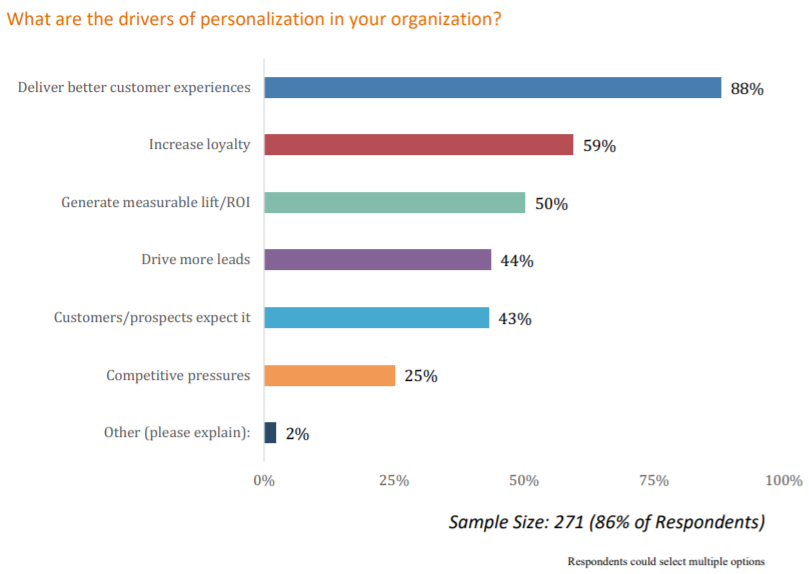
The point is, the content that speaks to one type of user won’t speak to another. A first-time visitor to your page has different needs than a visitor on their 20th session, for example.
Content personalization gives each of them slightly different pages filled with content that will appeal to their personal needs.

This chart from ConversionXL shows how two different versions of content are served to two different users.
4. Double-Down on Building Customer Loyalty with Authenticity & Transparency
According to a 2019 Stackla survey, 90% of consumers agree that authenticity matters for the brands they like and support. Most marketers are aware of this trend and want to be that authentic voice people crave.
The problem? 92% of marketers think the content they create oozes authenticity, but 51% of consumers think less than half of all brands accomplish this.
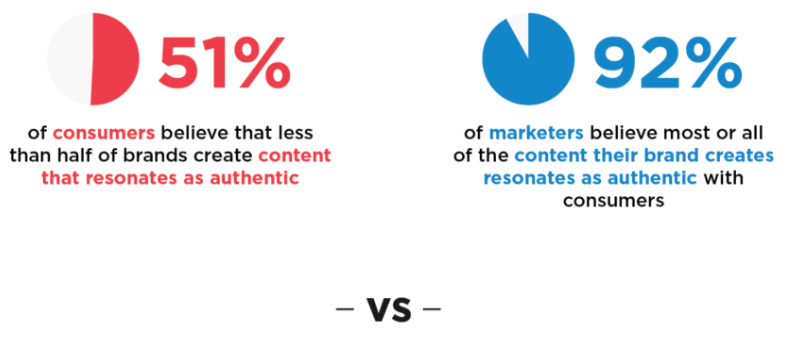
However, when brands get authenticity right, the rewards are huge. A Cohn & Wolfe survey found almost 90% of consumers are willing to reward a brand’s authenticity by taking action:
- 52% said they would recommend the brand to other people
- 49% would give the brand their loyalty
If marketers are often mistaken about the authenticity in their content, how can they get past their overconfidence and reach what works?
Brands that understand what authenticity actually means will come out on top. Michael Fertik for Forbes defines it like this:
“Being authentic means being accountable and upholding your brand promise. It requires transparency and a dash of vulnerability. When a brand is authentic, consumers know it, appreciate it and prioritize their spending accordingly.”
For examples of authenticity in big-name brands, look at Amazon, Apple, Lego, and Intel – all of these appear in Cohn & Wolfe’s list of the 100 Most Authentic Brands ranked by consumers.
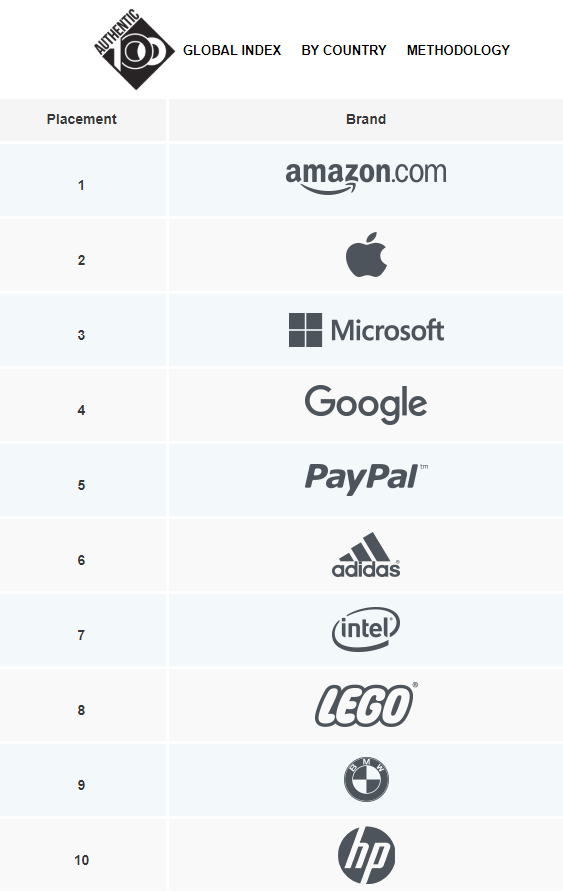
5. Expand Your Horizons Past Just Blogging
Blogging is a big deal in content marketing, but it’s not the end-all, be-all.
Blogging is awesome, don’t get me wrong.
My agency has seen 99% of our leads and sales come through our organic content rankings.
That said, we are living in a dynamic, multi-channel, multi-experience digital world.
If you only target people who read blogs and articles, you’re missing out on all the people who prefer only video, only audio, or a mix of two or three in their browsing adventures.
According to Nielsen, U.S. adults over age 18 now spend nearly half of their days – over 11 hours total – consuming content. (Over 6 of those hours are devoted to video content!)
They get their content everywhere: On live TV, time-shifted TV, the internet, smartphones, tablets, game consoles, radio, DVD/Blu-ray devices, and other internet-connected devices.
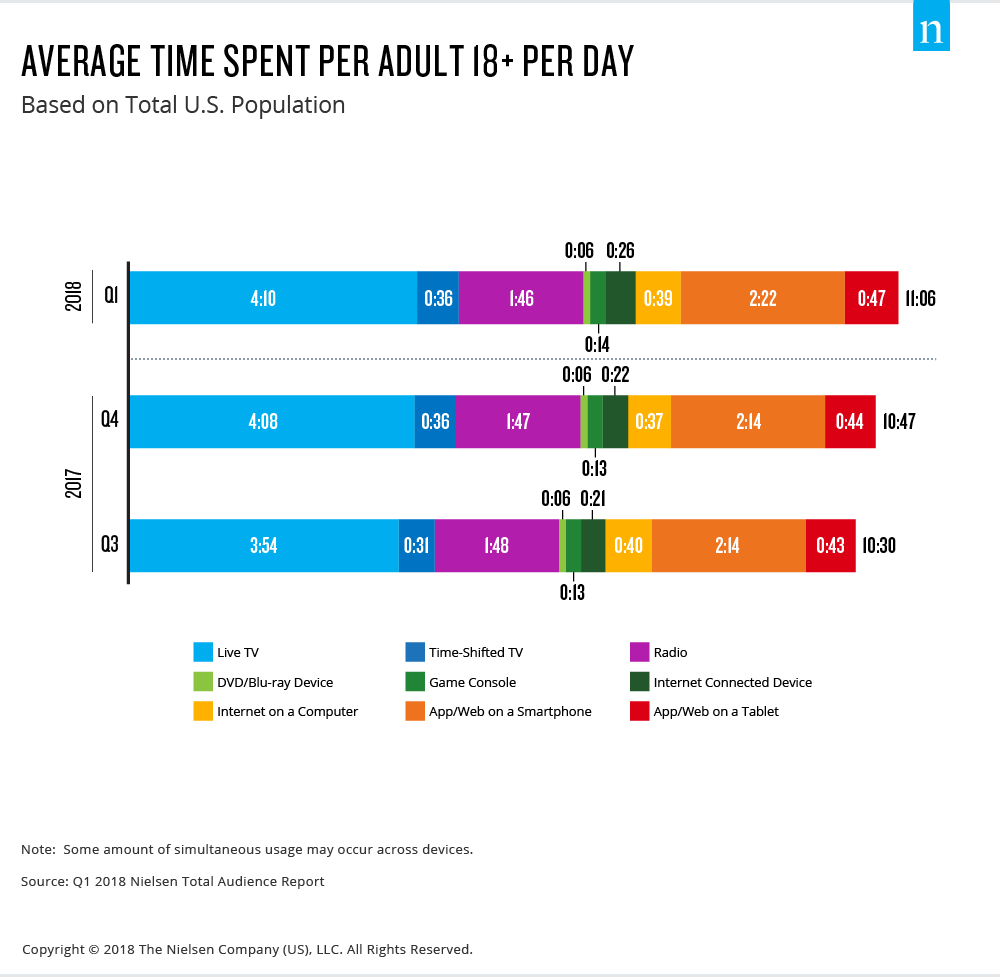
Most marketers are wise to this trend and are diving into the uncharted waters of YouTube, podcasts, webinars, and live streaming along with their blogging strategies.
If you’re still only blogging, it’s time to start thinking about adding on a YouTube channel, a podcast, or some other form of dynamic media to your content strategy.
For best results, go where your audience lives.
Trending Content & SEO Tactics Are Just the Beginning
As content marketing evolves, these trends are just the start of new shifts in the industry.
Over the last year alone, we have seen brands reprioritizing their audiences, refocusing on telling authentic stories, and shifting to include more channels in their content strategy.
Going forward, brands that invest in the right trends will see more growth overall. Are you ready?
SEO
Google Rolls Out New ‘Web’ Filter For Search Results

Google is introducing a filter that allows you to view only text-based webpages in search results.
The “Web” filter, rolling out globally over the next two days, addresses demand from searchers who prefer a stripped-down, simplified view of search results.
Danny Sullivan, Google’s Search Liaison, states in an announcement:
“We’ve added this after hearing from some that there are times when they’d prefer to just see links to web pages in their search results, such as if they’re looking for longer-form text documents, using a device with limited internet access, or those who just prefer text-based results shown separately from search features.”
We’ve added this after hearing from some that there are times when they’d prefer to just see links to web pages in their search results, such as if they’re looking for longer-form text documents, using a device with limited internet access, or those who just prefer text-based…
— Google SearchLiaison (@searchliaison) May 14, 2024
The new functionality is a throwback to when search results were more straightforward. Now, they often combine rich media like images, videos, and shopping ads alongside the traditional list of web links.
How It Works
On mobile devices, the “Web” filter will be displayed alongside other filter options like “Images” and “News.”
If Google’s systems don’t automatically surface it based on the search query, desktop users may need to select “More” to access it.
 Screenshot from: twitter.com/GoogleSearchLiaison, May 2024.
Screenshot from: twitter.com/GoogleSearchLiaison, May 2024.More About Google Search Filters
Google’s search filters allow you to narrow results by type. The options displayed are dynamically generated based on your search query and what Google’s systems determine could be most relevant.
The “All Filters” option provides access to filters that are not shown automatically.
Alongside filters, Google also displays “Topics” – suggested related terms that can further refine or expand a user’s original query into new areas of exploration.
For more about Google’s search filters, see its official help page.
Featured Image: egaranugrah/Shutterstock
SEO
Why Google Can’t Tell You About Every Ranking Drop

In a recent Twitter exchange, Google’s Search Liaison, Danny Sullivan, provided insight into how the search engine handles algorithmic spam actions and ranking drops.
The discussion was sparked by a website owner’s complaint about a significant traffic loss and the inability to request a manual review.
Sullivan clarified that a site could be affected by an algorithmic spam action or simply not ranking well due to other factors.
He emphasized that many sites experiencing ranking drops mistakenly attribute it to an algorithmic spam action when that may not be the case.
“I’ve looked at many sites where people have complained about losing rankings and decide they have a algorithmic spam action against them, but they don’t. “
Sullivan’s full statement will help you understand Google’s transparency challenges.
Additionally, he explains why the desire for manual review to override automated rankings may be misguided.
Two different things. A site could have an algorithmic spam action. A site could be not ranking well because other systems that *are not about spam* just don’t see it as helpful.
I’ve looked at many sites where people have complained about losing rankings and decide they have a…
— Google SearchLiaison (@searchliaison) May 13, 2024
Challenges In Transparency & Manual Intervention
Sullivan acknowledged the idea of providing more transparency in Search Console, potentially notifying site owners of algorithmic actions similar to manual actions.
However, he highlighted two key challenges:
- Revealing algorithmic spam indicators could allow bad actors to game the system.
- Algorithmic actions are not site-specific and cannot be manually lifted.
Sullivan expressed sympathy for the frustration of not knowing the cause of a traffic drop and the inability to communicate with someone about it.
However, he cautioned against the desire for a manual intervention to override the automated systems’ rankings.
Sullivan states:
“…you don’t really want to think “Oh, I just wish I had a manual action, that would be so much easier.” You really don’t want your individual site coming the attention of our spam analysts. First, it’s not like manual actions are somehow instantly processed. Second, it’s just something we know about a site going forward, especially if it says it has change but hasn’t really.”
Determining Content Helpfulness & Reliability
Moving beyond spam, Sullivan discussed various systems that assess the helpfulness, usefulness, and reliability of individual content and sites.
He acknowledged that these systems are imperfect and some high-quality sites may not be recognized as well as they should be.
“Some of them ranking really well. But they’ve moved down a bit in small positions enough that the traffic drop is notable. They assume they have fundamental issues but don’t, really — which is why we added a whole section about this to our debugging traffic drops page.”
Sullivan revealed ongoing discussions about providing more indicators in Search Console to help creators understand their content’s performance.
“Another thing I’ve been discussing, and I’m not alone in this, is could we do more in Search Console to show some of these indicators. This is all challenging similar to all the stuff I said about spam, about how not wanting to let the systems get gamed, and also how there’s then no button we would push that’s like “actually more useful than our automated systems think — rank it better!” But maybe there’s a way we can find to share more, in a way that helps everyone and coupled with better guidance, would help creators.”
Advocacy For Small Publishers & Positive Progress
In response to a suggestion from Brandon Saltalamacchia, founder of RetroDodo, about manually reviewing “good” sites and providing guidance, Sullivan shared his thoughts on potential solutions.
He mentioned exploring ideas such as self-declaration through structured data for small publishers and learning from that information to make positive changes.
“I have some thoughts I’ve been exploring and proposing on what we might do with small publishers and self-declaring with structured data and how we might learn from that and use that in various ways. Which is getting way ahead of myself and the usual no promises but yes, I think and hope for ways to move ahead more positively.”
Sullivan said he can’t make promises or implement changes overnight, but he expressed hope for finding ways to move forward positively.
Featured Image: Tero Vesalainen/Shutterstock
SEO
56 Google Search Statistics to Bookmark for 2024

If you’re curious about the state of Google search in 2024, look no further.
Each year we pick, vet, and categorize a list of up-to-date statistics to give you insights from trusted sources on Google search trends.
- Google has a web index of “about 400 billion documents”. (The Capitol Forum)
- Google’s search index is over 100 million gigabytes in size. (Google)
- There are an estimated 3.5 billion searches on Google each day. (Internet Live Stats)
- 61.5% of desktop searches and 34.4% of mobile searches result in no clicks. (SparkToro)
- 15% of all Google searches have never been searched before. (Google)
- 94.74% of keywords get 10 monthly searches or fewer. (Ahrefs)
- The most searched keyword in the US and globally is “YouTube,” and youtube.com gets the most traffic from Google. (Ahrefs)
- 96.55% of all pages get zero search traffic from Google. (Ahrefs)
- 50-65% of all number-one spots are dominated by featured snippets. (Authority Hacker)
- Reddit is the most popular domain for product review queries. (Detailed)
- Google is the most used search engine in the world, with a mobile market share of 95.32% and a desktop market share of 81.95%. (Statista)


- Google.com generated 84.2 billion visits a month in 2023. (Statista)
- Google generated $307.4 billion in revenue in 2023. (Alphabet Investor Relations)
- 63.41% of all US web traffic referrals come from Google. (SparkToro)
- 92.96% of global traffic comes from Google Search, Google Images, and Google Maps. (SparkToro)
- Only 49% of Gen Z women use Google as their search engine. The rest use TikTok. (Search Engine Land)
- 58.67% of all website traffic worldwide comes from mobile phones. (Statista)
- 57% of local search queries are submitted using a mobile device or tablet. (ReviewTrackers)


- 51% of smartphone users have discovered a new company or product when conducting a search on their smartphones. (Think With Google)
- 54% of smartphone users search for business hours, and 53% search for directions to local stores. (Think With Google)
- 18% of local searches on smartphones lead to a purchase within a day vs. 7% of non-local searches. (Think With Google)
- 56% of in-store shoppers used their smartphones to shop or research items while they were in-store. (Think With Google)
- 60% of smartphone users have contacted a business directly using the search results (e.g., “click to call” option). (Think With Google)
- 63.6% of consumers say they are likely to check reviews on Google before visiting a business location. (ReviewTrackers)
- 88% of consumers would use a business that replies to all of its reviews. (BrightLocal)
- Customers are 2.7 times more likely to consider a business reputable if they find a complete Business Profile on Google Search and Maps. (Google)
- Customers are 70% more likely to visit and 50% more likely to consider purchasing from businesses with a complete Business Profile. (Google)
- 76% of people who search on their smartphones for something nearby visit a business within a day. (Think With Google)
- 28% of searches for something nearby result in a purchase. (Think With Google)
- Mobile searches for “store open near me” (such as, “grocery store open near me” have grown by over 250% in the last two years. (Think With Google)
- People use Google Lens for 12 billion visual searches a month. (Google)
- 50% of online shoppers say images helped them decide what to buy. (Think With Google)
- There are an estimated 136 billion indexed images on Google Image Search. (Photutorial)
- 15.8% of Google SERPs show images. (Moz)
- People click on 3D images almost 50% more than static ones. (Google)
- More than 800 million people use Google Discover monthly to stay updated on their interests. (Google)
- 46% of Google Discover URLs are news sites, 44% e-commerce, 7% entertainment, and 2% travel. (Search Engine Journal)
- Even though news sites accounted for under 50% of Google Discover URLs, they received 99% of Discover clicks. (Search Engine Journal)


- Most Google Discover URLs only receive traffic for three to four days, with most of that traffic occurring one to two days after publishing. (Search Engine Journal)
- The clickthrough rate (CTR) for Google Discover is 11%. (Search Engine Journal)
- 91.45% of search volumes in Google Ads Keyword Planner are overestimates. (Ahrefs)
- For every $1 a business spends on Google Ads, they receive $8 in profit through Google Search and Ads. (Google)
- Google removed 5.5 billion ads, suspended 12.7 million advertiser accounts, restricted over 6.9 billion ads, and restricted ads from showing up on 2.1 billion publisher pages in 2023. (Google)
- The average shopping click-through rate (CTR) across all industries is 0.86% for Google Ads. (Wordstream)
- The average shopping cost per click (CPC) across all industries is $0.66 for Google Ads. (Wordstream)
- The average shopping conversion rate (CVR) across all industries is 1.91% for Google Ads. (Wordstream)
- 58% of consumers ages 25-34 use voice search daily. (UpCity)
- 16% of people use voice search for local “near me” searches. (UpCity)
- 67% of consumers say they’re very likely to use voice search when seeking information. (UpCity)
- Active users of the Google Assistant grew 4X over the past year, as of 2019. (Think With Google)
- Google Assistant hit 1 billion app installs. (Android Police)
- AI-generated answers from SGE were available for 91% of entertainment queries but only 17% of healthcare queries. (Statista)
- The AI-generated answers in Google’s Search Generative Experience (SGE) do not match any links from the top 10 Google organic search results 93.8% of the time. (Search Engine Journal)
- Google displays a Search Generative element for 86.8% of all search queries. (Authoritas)


- 62% of generative links came from sources outside the top 10 ranking organic domains. Only 20.1% of generative URLs directly match an organic URL ranking on page one. (Authoritas)
- 70% of SEOs said that they were worried about the impact of SGE on organic search (Aira)
Learn more
Check out more resources on how Google works:
-

 PPC6 days ago
PPC6 days agoHow the TikTok Algorithm Works in 2024 (+9 Ways to Go Viral)
-

 SEO5 days ago
SEO5 days agoHow to Use Keywords for SEO: The Complete Beginner’s Guide
-

 MARKETING6 days ago
MARKETING6 days agoHow To Protect Your People and Brand
-

 MARKETING4 days ago
MARKETING4 days agoAdvertising on Hulu: Ad Formats, Examples & Tips
-

 MARKETING4 days ago
MARKETING4 days agoUpdates to data build service for better developer experiences
-

 MARKETING5 days ago
MARKETING5 days agoThe Ultimate Guide to Email Marketing
-

 SEO7 days ago
SEO7 days agoAutomate Multi-Site Reporting With Google Sheets And GSC API
-

 MARKETING20 hours ago
MARKETING20 hours ago18 Events and Conferences for Black Entrepreneurs in 2024













